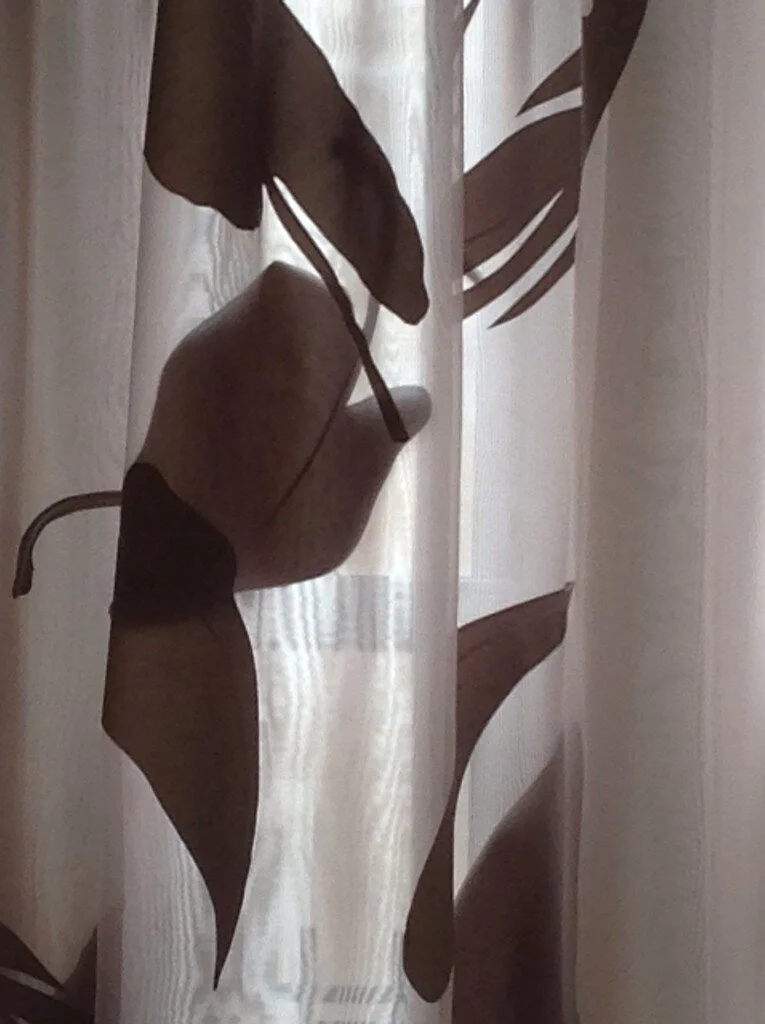What Light Through Yonder Window Breaks?
Curtains, drapes, drapery, swags, blinds, valances, passementerie … window treatments seem to have their own vocabulary. They also seem to cause the most fear and insecurity in my clients. I think people are afraid because window treatments tend to be one of the more expensive things you can do to decorate a room. All that fabric! All that hardware! We want to look out our windows, but sometimes they seem to chop into the décor of a room. Yet we wouldn’t want rooms without windows at all, would we?
When I was at Pratt getting my BFA, we were taught in the Bauhaus tradition – which meant doing pretty much nothing with or around windows. Just maybe a shade for privacy. Gradually, however, I came to learn that doing things around windows meant that you could do things to soften a room’s look, to add lushness and to add ‘loose’ fabric. To draw eyes towards or away from a window. To fix shortcomings or problems. A window isn’t just a space to let light and air in, it can be an extension of the decorative – and architectural – vision of a room.
Let me take you on a quick tour of six different windows and you’ll see what I mean.
Before I do that, a couple of definitions. Curtains vs. drapes or drapery – curtains are generally a single piece of unlined fabric, sheer, lightweight and less formal than drapes, which are heavier, usually lined, and can be opened and closed with a cord or drapery pull. You’ll find curtains in kitchens, bedrooms and bathrooms, and drapes in the living room. But this isn’t always a hard and fast rule you’ll see. Passementerie is a French word meaning lace or lace-making and refers to trimmings or edgings of braid, gold or silver cord, embroidery, colored silk or beads. A valance is simply a length of decorative drapery hung above a window to screen the curtain fittings.
Chelsea Loft NYC
In a modern loft in New York’s Chelsea, I wanted to make the window treatments contemporary and clean. Here I recreated a Shoji-style screen using a translucent fabric. The panels telescope, sliding over one another, to press into a single panel if desired. As they close, the panels become opaque, blocking light in certain spots and creating contrasting light and dark. It’s a modern, architectural solution to create privacy and a little softness using the lightweight, textured fabric. For someone who likes clean, modern-looking windows this is a good solution. The panels end at the windowsill level, leaving open the airflow from the HVAC (windowsill-level HVAC is very common in New York City apartments).
What if you have a fantastic view you don’t want to cover up with yards of fabric? But you want something to soften the window and to incorporate it with the rest of the room. In this Trump Tower apartment I attached a very sheer, textured fabric to a pulley. The fabric can be pulled to hang straight over the window or to fall like a handkerchief. Here, the curtain – though in its sculptural quality and use of hardware it’s more like a drape – is used like a piece of couture fabric and it’s something to look at in itself.
Beekman Place Apartment NYC
In this Beekman Place apartment the windows aren’t particularly interesting, nor is there much of a view. Here I keep the windows as part of the background rather than competing with the room’s focal point – the wall with the two large bookcases. The drapes are in the same color as the wall and they become an extension of the wall. They’re simple, elegant, quiet.
Upper East Side Apartment NYC
In this Upper East Side apartment, the window faces the apartment’s front door, so it’s the first thing you see when you walk in. With a large dining table in the center of the room, and not much else, this was also a typical New York apartment with the HVAC right below the windowsill. This curtain had a previous life; I collaborated with Adeline Olmer and Blane Charles on its design. We’d created it originally for our installation in DIFFA’S 2013 DINING BY DESIGN and re-purposed it for this dining room (aptly). The leaves are hand-cut and hand-sewn onto the sheer organza fabric. The hem, unusually at the top rather than the bottom, left us with a kind of pocket at the bottom which we filled with crystals, weighting the curtain and adding sparkle that references the room’s centerpiece, a Murano glass chandelier with its typically biomorphic soft contours. It’s a simple solution – light comes in during the day, and it sparkles at night!
Columbus Circle NYC
You need light-blocking in a bedroom, but how to keep the room from feeling like the inside of a box when the drapes are closed? This is the Columbus Circle bedroom of an art collector, where the decoration is subdued and almost monochrome to serve as a backdrop for the collection. Here I used texture to make the drapes interesting. The leading edge is quilted, and I’ve scattered seed-pearl beads on the elegant Fortuny fabric. This is couture drapery. The drapes look lovely when they’re closed and they’re smoothly integrated into the room’s decorative whole, completing the bedroom’s quiet, restful elegance.
East Hampton NY
The windows in this East Hampton house are short and low, with the windowsills only a couple of feet from the floor and ending way short of the ceiling. I placed a valance – with no curtains or drapes underneath – at the top of the wall. It hides where the windows end and makes them seem taller and the ceiling higher. The window frame itself is not hidden except at the very top and becomes a strong architectural element that frames the view of the woods outside.






